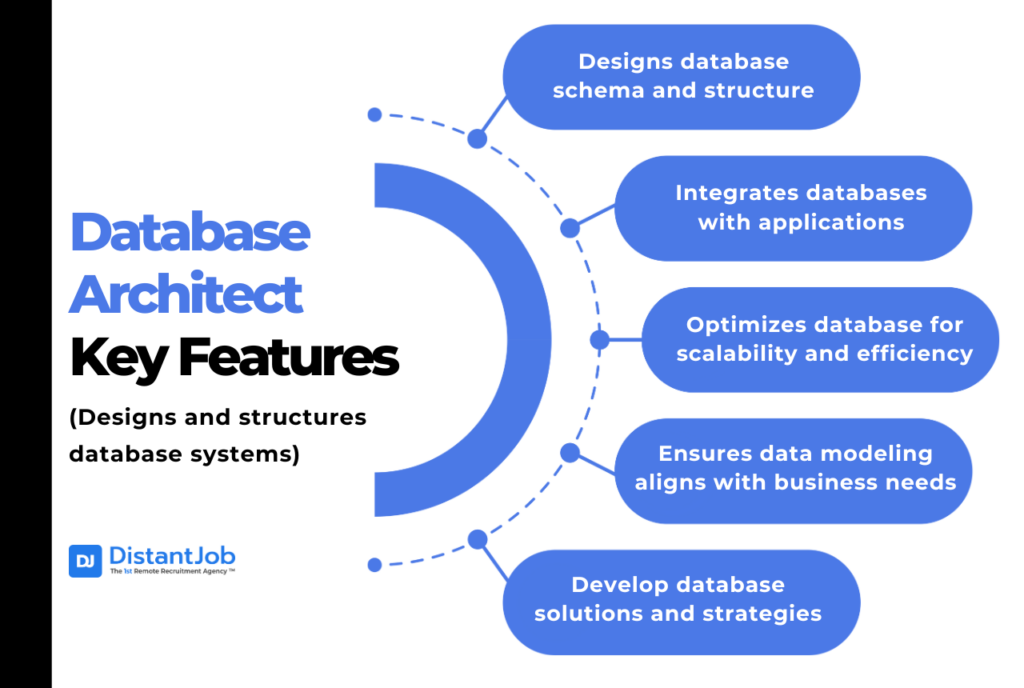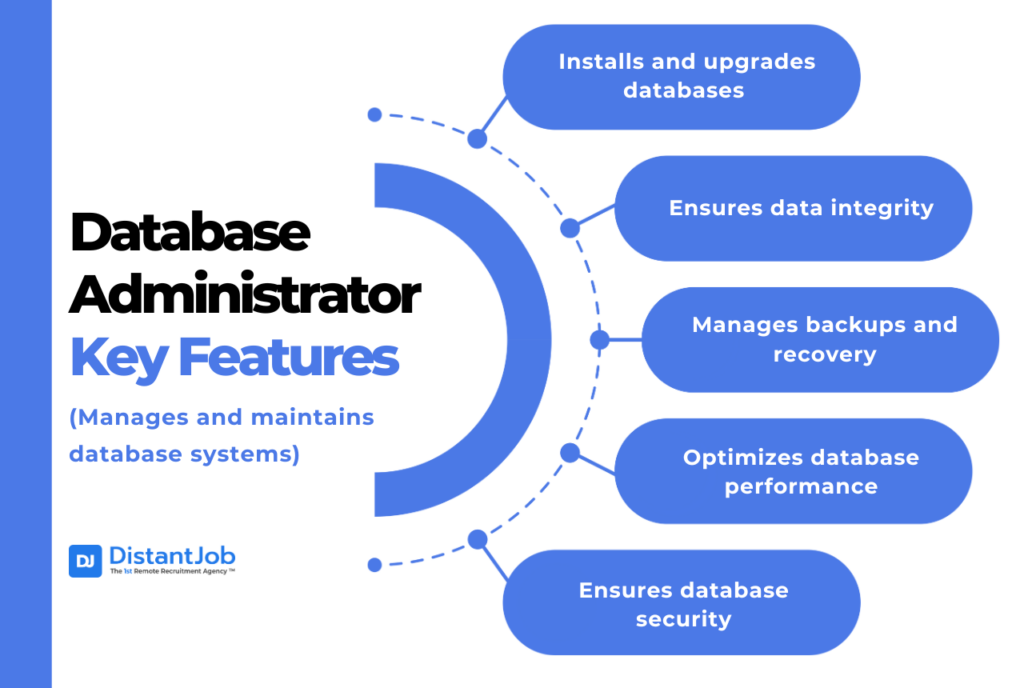Database Architects and Database Administrators (DBAs) have essential roles in managing and organizing data systems, but their duties differ a lot. Database Architects design and structure the databases, while DBAs handle daily maintenance and performance.
The Bureau of Labor Statistics reports that DBA jobs will increase by 9% from 2021 to 2031. This number shows the growing need to manage data in today’s business scene.
As businesses grow worldwide and handle huge amounts of data, it’s essential to understand these roles to optimize database design and maintenance. Whether you’re hiring locally or tapping into the global talent pool, knowing the right position for your data management needs can have a big impact on your company’s productivity.
Not sure which role is the best fit for your company’s data needs? In this article, we’ll explain the main differences between Database Architects (DAs) and Database Administrators (DBAs) to help you make the right choice.
Database Architect vs. Data Architect – The Key Differences
While there is some overlap between both jobs, there is a major difference between database architects and database administrators. Put simply, database architects work on structuring and optimizing databases, while data architects focus on enterprise-wide data flow and strategy.
Here’s a breakdown:
The Main Differences Bettwen Database Architect and Data Architects
Compare the key roles and responsibilities side by side.
| Category | 💾 Database Architect | 📊 Data Architect |
|---|---|---|
| Primary Focus | Designs, implements, and optimizes **database structures** for data storage and retrieval. | Develops **data strategies, governance, and high-level models** for enterprise-wide data management. |
| Key Responsibilities | Creates relational databases, optimizes queries, ensures scalability, and improves performance. | Defines **data flow, security, integration, and overall data strategy** for business use. |
| Tools & Technologies | SQL, MySQL, PostgreSQL, Oracle, MongoDB, indexing, query optimization. | ETL tools, Data Lakes, Cloud Platforms (AWS, Azure), Data Modeling (ERDs, Star Schema). |
| Best For | Companies needing **optimized databases** for application performance and data consistency. | Businesses looking to **define enterprise-wide data strategies** for analytics and AI/ML. |
| Common Role in Teams | Works closely with **developers & database administrators** to structure storage solutions. | Collaborates with **business leaders & data engineers** to define strategic goals. |
Database architects (DAs) plan, design, and develop the architecture of a database system, focusing on the strategic implementation of new technologies and systems. Database administrators (DBAs), on the other hand, maintain and operate the existing database systems.
Database architects must have a high level of technical expertise, as they are responsible for ensuring the most efficient and secure data systems. Database administrators, however, must have the ability to manage and use the system, as well as troubleshoot any technical issues that may arise.
Let’s go into more detail about each role.
Put simply, a DBA manages and optimizes the performance of existing databases, while database architects design and implement new database systems.
What is a Database Architect?
If your data isn’t organized or secure, it’s impossible to make use of that data efficiently. This is where a database architect steps in.
A database architect’s role involves creating and designing a database that meets a company’s specific needs. They begin by studying and analyzing their employer’s objectives, goals, and current data infrastructure, identifying areas for improvement. To achieve this, they:
- Developing the models needed to ensure both scalability and security and then implement and test them.
- Ensuring that the database meets any industry regulations and data security standards when dealing with sensitive data.
- Creating technical documentation pertaining to a database’s functionality, its ancillary tools, and how they work together to provide all the needed functionality.
In simpler words, they map out how the database should look and work.
What does a Database Architect do?

A database architect is responsible for designing and managing database systems for organizations, focusing on creating efficient, secure, and scalable solutions.
Roles and Responsibilities
Database architects collaborate closely with software designers and analysts to develop comprehensive, easy-to-use databases. They first assess the company’s core needs and current data infrastructure before determining the optimal database model.
Their main responsibilities are:
- Designing effective database solutions and models for a company/client.
- Identifying database structural necessities by evaluating client operations and applications.
- Preparing database architecture reports for management teams.
- Installing and organizing information systems to guarantee functionality, security and scalability.
- Monitoring closely how the system is performing by doing tests, troubleshooting, and integrating new features.
Database architect skills:
- Applied math and statistics
- Data visualization and data migration
- Database Management System (DBMS) software
- Programming languages (SQL, Python, and Java)
- Design skills
- Cloud architecture and integration
Types of Database Architects:
There are several database architects, each specializing in different aspects of database design and management. Here are some common types:
- Enterprise Database Architect: Designs and manages the architecture for an entire organization, developing strategic data storage and usage plans.
Example: An Enterprise Database Architect may oversee the data infrastructure for a global retailer. - Data Warehouse Architect: Focuses on building data warehouses for analytics and business intelligence, integrating multiple data sources into a single, central repository.
Example: A Data Warehouse Architect might work for a financial firm, creating systems to streamline reporting and analysis across departments. - Database Solution Architect: Develops customized database solutions for specific business needs, ensuring systems are tailored to unique applications.
Example: This role often involves working with teams to design specific database applications for industries like healthcare. - Cloud Database Architect: Specializes in designing and managing databases in cloud environments such as AWS, Azure, or Google Cloud, building scalable cloud-based systems.
Example: A Cloud Database Architect may work with a startup to scale its cloud infrastructure for growth. - NoSQL Database Architect: Works with NoSQL databases used for large data sets and real-time applications.
Example: A NoSQL Database Architect may design systems for social media platforms that handle massive amounts of unstructured data. - Big Data Architect: Focuses on big data technologies like Hadoop and Spark, managing vast volumes of unstructured data.
Example: A Big Data Architect might help an e-commerce company analyze customer behavior and purchasing patterns in real time.
What is a Database Administrator?
Building and creating a database is one thing. Managing and organizing data is a completely different thing.
The role of a database administrator (DBA) consists of using the latest technological tools to store and organize an organization’s critical data. They ensure that a company’s database is secure and accessible.
DBAs play a key role in businesses handling large datasets. Beyond organizing data, they help businesses develop strategic data management plans.
For example, a DBA ensures databases are secure and functional while also working closely with data analysts to support business decisions with accurate data insights. This collaboration is essential for transforming data into actionable business strategies.
What does a Database Administrator do?

A Database Administrator (DBA) is tasked with maintaining the performance, integrity, and security of a company’s databases.
Roles and Responsibilities:
Their main responsibilities are:
- Installation and Maintenance: Installing and upgrading database servers and application tools.
- Setting Up Databases: Creating and maintaining databases according to the needs of users and applications.
- Data Management: Ensuring the databases are available to all relevant users and are secure from unauthorized access.
- Performance Monitoring: Monitoring database performance and implementing changes for improvement.
- Backup and Recovery: Implementing and testing backup and recovery plans to ensure data integrity and availability.
- Security: Managing database security, creating and maintaining user access permissions and privileges.
- Troubleshooting: Identifying and resolving any issues related to databases.
- Data Modeling and Design: Working on the design of database structures, data modeling, and schema refinement.
Database administrator skills:
- Knowledge of database design
- Understanding of relational DataBase Management Systems (DBMS)
- Structured Query Language (SQL or Transact-SQL)
- Analytical and problem-solving skills
- Data security
- ERP and business knowledge
Types of Database Administrators:
Database Administrators (DBAs) can specialize in various areas, reflecting the diverse needs of database management. Here are some common types:
- System DBA: Focuses on the physical and technical aspects of database management, such as installing and upgrading the database servers, ensuring efficient performance, and managing backups and recovery plans.
Example: A System DBA ensures smooth database server upgrades at a global fintech company, minimizing downtime during system maintenance. - Application DBA: Works more on the application side of databases, dealing with database integration for specific applications, ensuring that the database supports application requirements, and managing data and database structures related to specific applications.
Example: An Application DBA works at a healthcare provider, ensuring the database supports an electronic health records (EHR) system, improving patient data access. - Database Warehouse Administrator: Specializes in managing data warehouses. This involves handling large volumes of data, optimizing data retrieval, and ensuring data warehouse systems work efficiently with other business intelligence tools.
Example: At a multinational retailer, a Data Warehouse DBA organizes sales data for effective analysis and reporting. - Network DBA: This position focuses on managing databases in networked environments. It ensures that databases across a network are optimized for performance and security.
Example: A Network DBA at a telecommunications company ensures that databases across global data centers run efficiently and securely. - Cloud DBA: Specializes in managing databases in cloud environments. They work with cloud-based database services, ensuring the scalability, availability, and security of databases in the cloud.
Example: A Cloud DBA ensures smooth migration of a SaaS platform’s database to AWS, enabling seamless scaling for increased user demands. - Performance DBA: This position focuses on optimizing database performance. They analyze, troubleshoot, and improve database performance and efficiency.
Example: A Performance DBA at a large e-commerce company tweaks database settings to reduce query times during high-traffic sales events. - Security DBA: This position concentrates on securing the database. This involves setting up robust security protocols, monitoring for security breaches, and ensuring compliance with data protection regulations.
Example: A Security DBA at a financial institution implements strict encryption measures to comply with GDPR and prevent unauthorized data access.
Database Architect vs. Database Administrator: Table of Comparison
It’s now become clear that database architects and database administrators have different roles in managing a company’s data systems.
Architects design and develop the structure of databases, while administrators manage and maintain them. Both jobs play a crucial part in keeping data systems running , but they have unique focuses and duties.
Let’s compare these roles side by side to see how they differ. This comparison will give you a better idea of how each job supports a company’s data strategy and operations:
| Comparison | Database Administrator (DBA) | Database Architect |
|---|---|---|
| Main Role | Manages and maintains database systems. Example: A DBA ensures uptime and data security for a healthcare provider’s patient records. | Designs and structures database systems. Example: A database architect designs scalable systems for a global e-commerce platform’s customer data. |
| Key Responsibilities | – Installs and upgrades databases. – Ensures data integrity. – Manages backups and recovery. – Optimizes database performance. – Ensures database security. Example: A DBA for a retail chain ensures smooth Black Friday transactions. | – Designs database schema and structure. – Integrates databases with applications. – Optimizes database for scalability and efficiency. – Ensures data modeling aligns with business needs. – Develop database solutions and strategies. Example: An architect creates cloud-based solutions for a data-driven tech firm. |
| Skills Required | – Database management – Backup and recovery techniques – Performance tuning – Security measures – Knowledge of SQL and database-specific languages Example: A DBA at a financial institution optimizes security protocols for sensitive customer data. | – Data modeling – System design and architecture – Knowledge of SQL and other database languages – Understanding of business processes – Big data and cloud technologies Example: A database architect at a startup designs systems for rapid scaling. |
| Tools & Technologies | SQL Server, Oracle, MySQL, backup and recovery tools Example: A DBA uses Oracle to implement robust recovery systems for a multinational bank. | Data modeling tools, SQL, NoSQL, cloud database services Example: An architect implements AWS cloud services for a logistics company managing big data. |
| Focus Area | Operational efficiency and security of existing database systems Example: A DBA reduces downtime for an online retail business during peak hours. | Strategic planning and design for new database systems Example: A database architect ensures future-proof architecture for a growing AI startup. |
| Typical Challenges | Handling data recovery, ensuring uptime, managing performance issues Example: A DBA resolves performance lags for a streaming service during high-demand hours. | Balancing technical and business requirements, adapting to new technologies Example: A database architect designs flexible systems to integrate emerging AI solutions in a marketing company. |
| Career Path | Progresses to senior DBA roles, potentially to database management Example: A DBA at a large corporation moves to a leadership role overseeing database teams across multiple regions. | Progresses to senior architect roles, data strategy roles Example: A database architect moves to a chief data officer role in a multinational enterprise. |
Conclusion
In conclusion, while both Database Administrators (DBAs) and Database Architects play crucial roles in the management and design of database systems, their responsibilities, skill sets, and focus areas significantly differ. DBAs are primarily responsible for the operational management and maintenance of databases, focusing on aspects like performance tuning, security, and data recovery.
Database Architects, on the other hand, are more involved in the strategic planning and design of database structures, ensuring scalability, efficiency, and alignment with business needs.
For businesses, understanding the nuances between these roles can enhance IT resource allocation, ensuring data systems run optimally while adapting to ever-evolving requirements in the tech landscape.
If you’re looking to hire either a Database Architect or a Database Administrator, DistantJob is your partner in finding the right talent. With over a decade of experience in connecting companies with top-tier IT professionals, we manage every step of the recruitment process to ensure you get the best fit.From sourcing candidates to handling the HR side of things, we make hiring hassle-free. Let us help you find the skilled data expert your business needs to thrive. Reach out today to get started!






